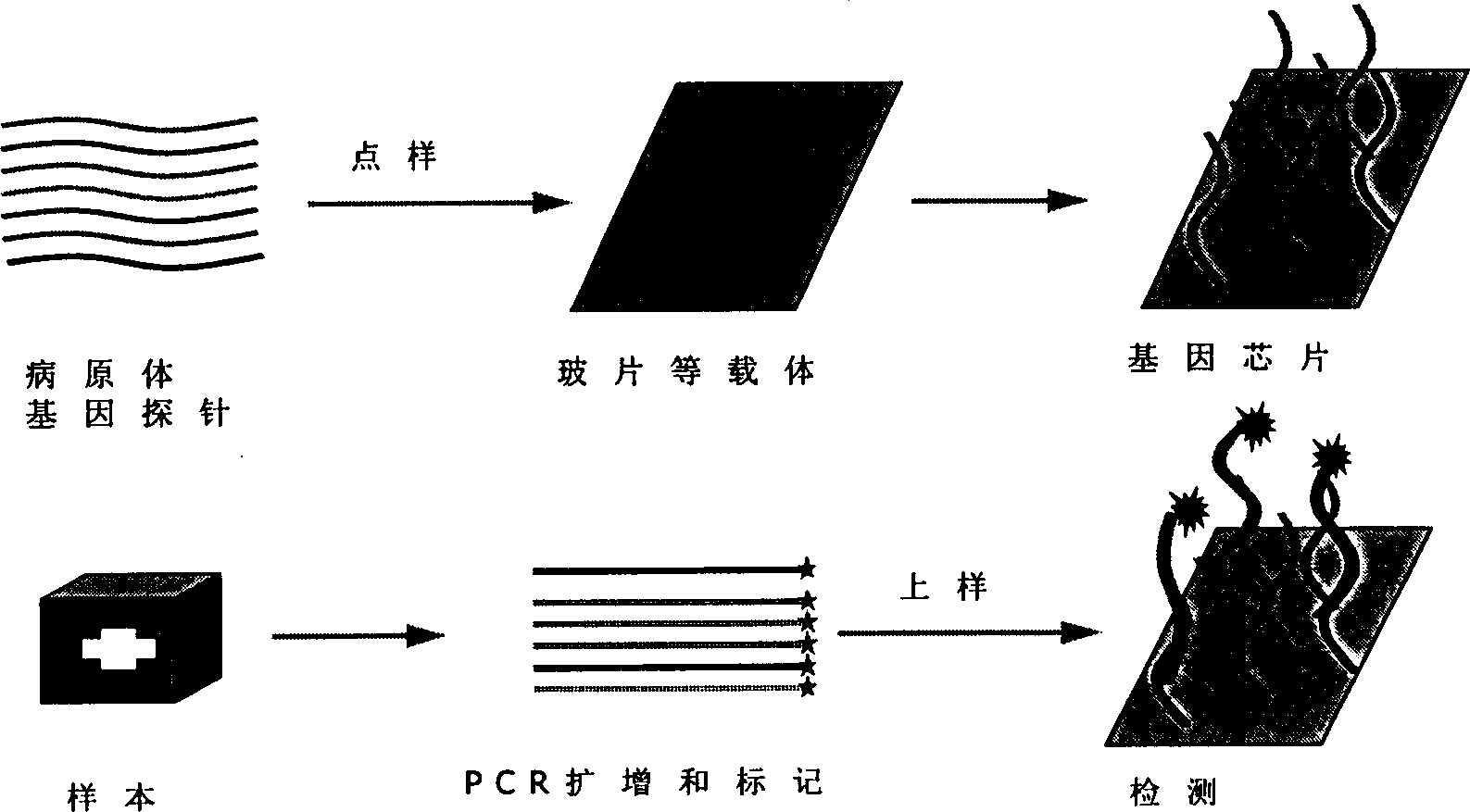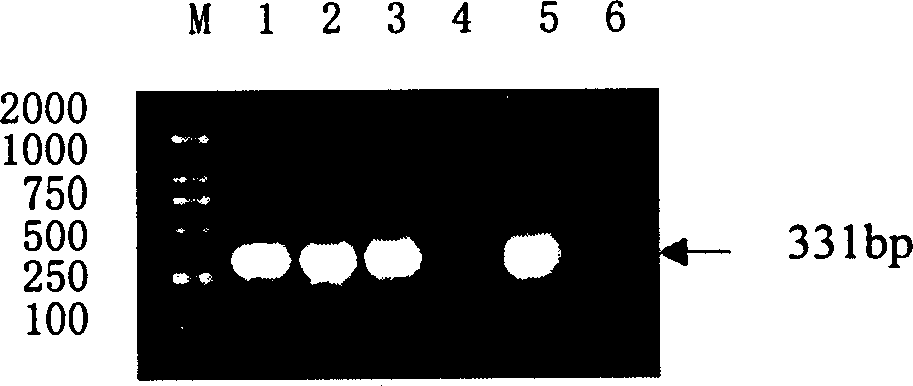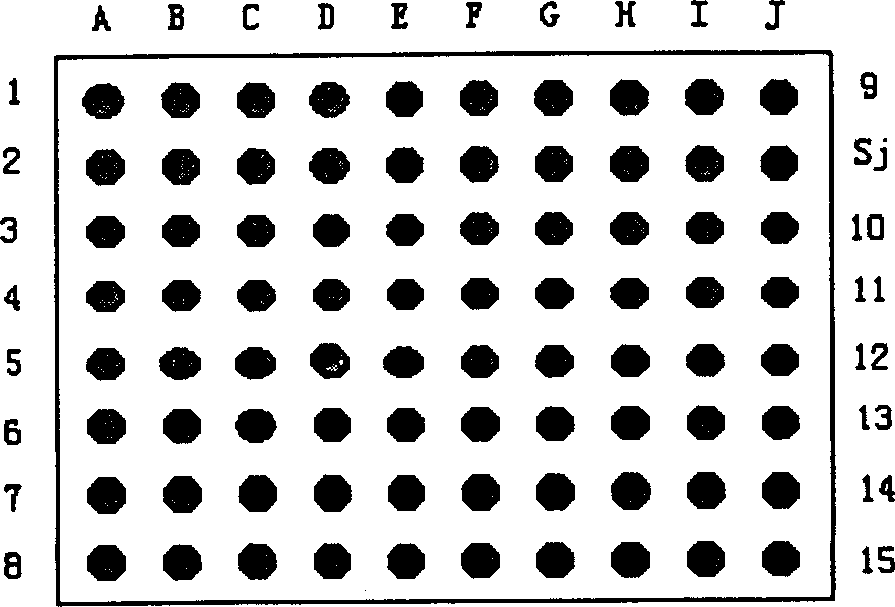Detection type gene chip for detecting various infectious desease and use thereof
A technology for gene chips, infectious diseases, applied in the fields of resistance to vector-borne diseases, determination/examination of microorganisms, biochemical equipment and methods, etc.
- Summary
- Abstract
- Description
- Claims
- Application Information
AI Technical Summary
Problems solved by technology
Method used
Image
Examples
Embodiment 1
[0057] A detection-type gene chip for detecting multiple infectious diseases, including template processing and amplification; carriers such as glass slides, silicon wafers, etc.; modification of arm molecules on the carrier surface; oligonucleotide probes (including detection of oligonucleotides) acid probes and quality control probes) and their curing; detection and analysis, etc. Example 1. Development and preliminary application of a gene chip for detection and typing of malaria parasites
[0058] Malaria is a parasitic disease that seriously endangers human health. Especially in the event of floods, large-scale crowd gatherings, and bioterrorism, the threat of epidemics is still relatively prominent. Efficient, sensitive, and rapid methods of monitoring malaria parasites are the primary prerequisite for malaria control. We established a gene chip for detecting and typing Plasmodium vivax and Plasmodium falciparum, optimized and determined the detection conditions of the ch...
Embodiment 2
[0109] For the detection results of Plasmodium vivax, Plasmodium falciparum infection and mixed infection, see Figure 4 . The results showed that the chip prepared in this paper can specifically detect Plasmodium vivax, Plasmodium falciparum and mixed infection, and no non-specific binding occurred in the control 6 pathogen samples and randomly selected healthy human blood samples, and the difference between the two types of Plasmodium No cross-reactivity. The blood samples of Plasmodium vivax and Plasmodium falciparum of appropriate density were serially diluted with whole blood of healthy people, the DNA template was quickly prepared by Tritonx-100 method, and after PCR parallel amplification, Agarose electrophoresis was performed, and positive bands could be seen under the gel imaging system The maximum dilution of Plasmodium vivax is 10 worms / μl, and that of Plasmodium falciparum is also 10 worms / μl. The above samples were used to prepare templates for chip simulation d...
Embodiment 3
[0122] Example 3. Establishment of a method for detecting Orientia tsutsugamushi DNA by gene chip technology
[0123] Scrub typhus is an insect-borne natural foci disease caused by Orientia tsutsugamushi. In recent years, the epidemic area in my country has been expanding. Because the disease is prone to misdiagnosis, resulting in improper treatment, and even death. Therefore, rapid and accurate diagnosis is extremely important. We selected the 56kD protein gene sequences of three standard strains of Orientia tsutsugamushi, which are both conserved and specific, synthesized oligonucleotide probes, and preliminarily established a diagnostic method for detecting Orientia tsutsugamushi-specific DNA using chip technology
[0124] 1. Design and synthesis of primers and probes
[0125] According to the sequence of the main surface antigen 56kD protein of Orientia tsutsugamushi standard strains Karp Gilliam and Kato[2,3], combined with computer software analysis and NCBI BLAST scre...
PUM
 Login to View More
Login to View More Abstract
Description
Claims
Application Information
 Login to View More
Login to View More - R&D
- Intellectual Property
- Life Sciences
- Materials
- Tech Scout
- Unparalleled Data Quality
- Higher Quality Content
- 60% Fewer Hallucinations
Browse by: Latest US Patents, China's latest patents, Technical Efficacy Thesaurus, Application Domain, Technology Topic, Popular Technical Reports.
© 2025 PatSnap. All rights reserved.Legal|Privacy policy|Modern Slavery Act Transparency Statement|Sitemap|About US| Contact US: help@patsnap.com



